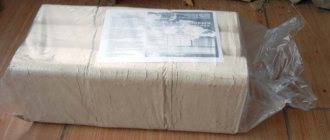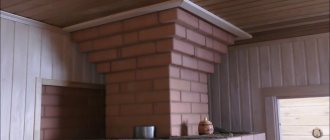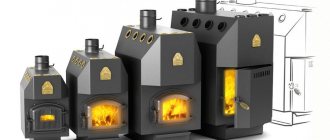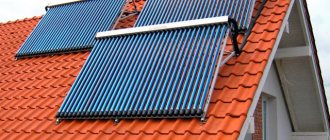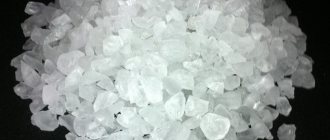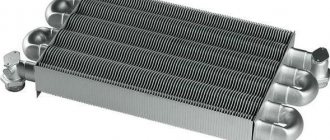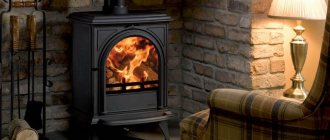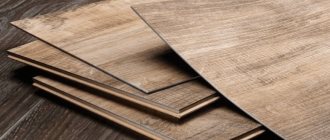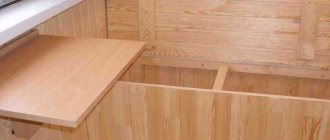DIY heating briquettes
Is it difficult to make wood heating briquettes at home without special equipment?
To do this, you will need the simplest lever press and a mold for Euro firewood. Sawdust or waste paper can be used as feedstock. Often these components are combined with each other to improve quality. To obtain a homogeneous mass in a peat heating briquette, a binder component is required. It could be water or clay. Then you will need to complete the following manufacturing steps:
- Crushing the feedstock and adding a binder component.
- Filling the form, pressing.
- Drying the workpiece.
Factory heating briquettes RUF are produced using the same technology. The difference lies in pressure and production volumes. At home, to provide fuel for the entire heating period, production time can take from 7 to 20 days.
Brown coal
Brown coal
appears in the form of a dense, earthy, woody or fibrous carbonaceous mass with a brown streak, with a significant content of volatile bituminous substances. It often has a well-preserved plant woody structure; the fracture is conchoidal, earthy or woody; color brown or pitch black; burns easily with a smoky flame, emitting an unpleasant, peculiar burning smell; when treated with caustic potassium it gives a dark brown liquid. During dry distillation it forms ammonia, free or associated with acetic acid. Specific gravity 0.5-1.5. Average chemical composition, excluding ash: 50-77% (average 63%) carbon, 26-37% (average 32%) oxygen, 3-5% hydrogen and 0-2% nitrogen.
The photo below shows brown coal.
Brown coal, as the name indicates, differs from hard coal in color (sometimes lighter, sometimes darker); There are, however, also black varieties, but in this case they are still brown in powder, while anthracite and coal always give a black line on a porcelain plate. A significant difference from hard coal is its lower carbon content and significantly higher content of bituminous volatiles. This explains why brown coal burns easier, produces more smoke, smell, and also the above-mentioned reaction with caustic potassium. The nitrogen content is also significantly lower than that of coal.
Literature
- , , “Energy-technological use of fuel”, M., 1956.
- Peat deposits and their integrated use in the national economy, M., 1970.
- The use of peat and depleted peatlands in agriculture, L., 1972.
- Peat in the national economy, M., 1968.
- Lishtvan I.I., Korol N.T., Basic properties of peat and methods for their determination, Minsk, 1975.
- , Peat deposits, M., "Nedra", 1976.
- A. F. Bowman, Soils and the Greenhouse Effect, 1990.
- Bezuglova O.
S. Fertilizers and growth stimulants. Retrieved February 22, 2015.
Articles
- // Great Russian Encyclopedia. Volume 32. - M., 2021. - P. 313-314.
- Peat // Technical encyclopedia. Volume 23. - M.: Soviet Encyclopedia, 1934. - Stb. 746—763
Regulatory documents
GOST 21123-85 Peat. Terms and Definitions
| (fossil fuels) |
| Coal row |
| Petroleum and naphthoid series |
| Main types | |
| Fossil | |
| Renewable and biological | |
| Artificial |
Production
The production process, as we have already said, is quite simple, even though it takes place at home.
To make briquettes for heating stoves with your own hands you need:
- Prepare high-quality raw materials, grind them to the desired consistency, and dry them. In order to improve the quality of combustion, paper can be added to any raw material.
- If necessary, add a binding element (clay, lignin), add water, and load it into the press machine.
- Press the product into a suitable shape at high pressure and preferably high temperature.
- Dry the finished product and, if possible, package it to protect it from external factors. When drying, you can use rags and paper that can draw out any remaining moisture from the briquette.
Having carried out all this work, you will receive excellent fuel, which can be used to easily and quickly heat a bathhouse and heat a house. At the same time, over a long period of time, you will experience the benefits and cost savings from using such eco-drives.
Note that during operation you should try to achieve a briquette moisture content of no more than 10-12% so that they burn well. Industrially produced briquettes have a moisture content of less than 10%.
To make sure of the excellent characteristics of this type of fuel, you can buy yourself some Euro briquettes to try in any store. At the same time, to create a suitable atmosphere, you can sometimes light a fireplace or stove with ordinary wood, because the use of different types of fuel is not mutually exclusive.
Back in the middle of the last century, in many regions of our country, where there were problems with wood, but livestock farming was developed, dung was a popular type of fuel. Then they were supplanted by coal supplies and gasification, but the topic of producing fuel briquettes from manure is still interesting.
Nowadays, manure is most often used in organic farming, as a natural and useful fertilizer. But these are not all areas of use of this natural raw material. We talked about adobe houses, where manure can also be used as a filler for construction briquettes. In addition, organic material is used in the production of biogas, which is also an alternative fuel.
Preparation of dung. Tsimlyanskaya village, 1875–1876
But we will not talk about biogas, but specifically about fuel briquettes made from manure, dung, which were actively used by our ancestors to heat houses with stove heating.
Dung is not just manure, animal waste. This is manure mixed with straw, sawdust, hay, pressed into small briquettes, bricks or cakes, and dried. In this form, manure becomes a good fuel for heating, for example, a greenhouse, a bathhouse or a country house, completely replacing firewood and even coal.
For comparison, here are the approximate energy content of various types of biological fuel:
| Fuel | MJ/kg | kW h/kg |
| Dry manure | 16 | 4,4 |
| Fresh wood with 60% moisture content | 6 | 1,7 |
| Street-dried wood with a moisture content of 20%, ordinary firewood | 15 | 4,2 |
| Straw in bales | 15 | 4,2 |
| Coal | 28 | 7,8 |
As you can see, the specific calorific value of dry manure is even slightly higher than that of firewood that was dried outside. In addition, dung burns with a smoldering flame; users note that their combustion properties are similar to brown coal.
The main advantage of manure as an alternative fuel is its efficiency. If you have your own farm - cows, goats, sheep, rabbits, other animals - then the fuel is absolutely free. You can ask your neighbors who farm and do not actively use manure themselves. A whole truck of manure can be ordered and purchased; it will cost about 11 thousand rubles.
Another plus is that ash from dung will be an excellent fertilizer; it is an environmentally friendly and waste-free fuel.
The main disadvantage of dung is that it takes a long time to make such fuel with your own hands; you have to put in a lot of effort. In addition, the very thought of having to tinker with such organic raw materials, animal feces, scares many people away. Note that, according to numerous reviews, there are no unpleasant odors during the burning of dung. Bread was previously baked in Russian ovens using this fuel.
In the process of producing briquettes from manure, of course, there is little pleasant, we agree. But in general, everyone involved in livestock farming is faced with the disposal of organic waste, so why not do it for the benefit of the farm.
Advantages and disadvantages
Not everyone is familiar with the advantages and disadvantages of peat briquettes and the rules for their use. Positive characteristics of peat fuel:
- It is environmentally friendly.
- Suitable for any type of stoves operating on solid fuel.
- It flares up quickly, there is no strong smoke.
- During combustion, less soot and soot are formed. Chimneys do not need frequent cleaning.
- No sparks are formed and no toxic substances are released.
- Maintain a comfortable temperature for ten hours.
- They have good heat dissipation. It is slightly worse than that of firewood, but higher than that of coal.
- Economical. During combustion, some ash remains (approximately 1% of the volume of each block).
- Ash can be used as phosphorus and lime fertilizer.
- Production is located directly at the site where raw materials are extracted. This allows you to save money on transportation and other stages.
- Briquettes are light in weight and have the correct shape. They are easy to transport, store and use. There is no need to saw, chop and dry firewood.
- Less space is required for storage. There is no need to create special conditions; it is enough to protect the fuel from moisture by building a canopy. Humidity should be no more than 80%.
- Pressed peat does not absorb much moisture and remains flammable during long-term storage.
- The material has an acceptable cost.
- Fuel is sold in kilograms, not cubic meters. You can buy only the quantity you need at any time.
- Natural peat reserves are replenished independently.
Good to know: soot cleaner for chimneys.
Peat fuel has a significant drawback. The raw material is highly flammable, you need to be careful when storing it.
Fuel briquettes made from peat can be used for heating in a country house, country house, veranda, summer kitchen, bathhouse, sauna, greenhouse, winter garden, utility buildings, lodges, trailers, warehouses. They can light a fireplace and use it in fuel boilers, or light a barbecue.
Features and types of peat
Peat is an organic rock that is the result of the biochemical process of rotting marsh plants due to excessive humidity and oxygen deficiency.
Peat includes plant fibers, humic acids and various microelements.
If we look at peat as a fuel, taking into account its main characteristics, then it can safely be called young coal. In terms of basic parameters, they are similar, however, peat extraction does not imply the creation of a complex developed infrastructure, because of this, its cost is significantly lower compared to coal.
The main feature of peat is its ash content. It refers to the amount of combustible products that remain after burning a kilogram of fuel. This parameter is measured as a percentage.
The ash content of peat also depends on its origin. Based on this, three types of this breed can be named.
| Type of peat | Peculiarities |
| Lowland | Consists of a large amount of rotted wood residues. It has a very high ash content (for some species it can reach 50%) and low thermal capacity. Because of these characteristics, it is often used in the preparation of natural fertilizers for clay soils. |
| Horse | The basis is the remains of marsh vegetation and sphang mosses. It has a low ash content of 1-5%. This peat is most often used for domestic purposes; it is most often used as the main raw material in the production of fuel. |
| Transition | This is something between lowland and highland peat. |
Of course, peat is not used as fuel in its pure form. After extraction, the natural material undergoes special processing, allowing rational and effective use of all its properties.
Therefore, the following types of peat can be distinguished depending on the characteristics of its processing.
| Type of peat | Peculiarities |
| Shredded/milled peat | This is a placer that is intended to be burned in suspension. |
| Semi-briquette / sod peat | Characterized by a low degree of compression, this fuel product is produced directly on the site of the deposit being developed. |
| Peat briquette | This is a high-calorie product with a significant degree of pressing. Due to the characteristics obtained as a result of processing, it is able to replace coal. A ton of peat briquettes in terms of the volume of heat generated is equal to 1.6 tons of brown coal and 4 m³ of firewood. Peat briquettes are stable in their thermal characteristics, this makes it possible to make accurate calculations of the fuel needs of a certain object. |
You can learn more about the manufacturers of fuel briquettes Ruf, Pini Kay, Nestro and Nilson on this page.
What is it and what is it made of?
In the bowels of the Earth today there is, according to the most conservative estimates, 250-500 billion tons of peat - and this is almost 3% of the land. At the same time, our country ranks 2nd after Canada in terms of energy mineral reserves. This type of fuel raw material is extremely popular in most European countries. For example, Finland actively uses peat fuel along with other types, and its share exceeds 30%.
In recent years, in order to use peat as fuel, peat briquettes have been produced, otherwise called “pellets”. They are made by pressing dried peat. For this purpose, crushed particles of the fossil are dried in special machines, then briquettes are made from it using a press. This is a fairly durable material made from pressed peat, the pieces of which have the same shape. The calorific value of peat in processed pellets is increased, which brings them closer to those of coal.
In most cases, briquettes are produced close to peat mines, which makes them one of the cheapest and most accessible solid fuels. Peat briquettes have many advantages. First of all, they are easy to light and are also extremely compact, which is convenient for storing them. The high calorific value of peat briquettes makes them a universal fuel option, since they can be used in different models of boilers that operate on solid fuel in boiler installations.
The process of converting gas and fuel oil boiler houses to peat briquettes is associated with a steady increase in prices for hydrocarbon fuels and has recently become widespread. Among other things, experts believe that peat bars are biologically safe fuel, which is one of the main advantages for many modern buyers.
A characteristic of peat is its ash content - this is an indicator of the amount of ash formed after 1 kg of fuel is burned. In this way, it is determined how high quality the raw materials are. Accordingly, the lower this indicator, the higher the quality of the product.
The types of peat used in the production of briquettes can be classified into varieties based on the origin of the fossil.
- The upper one, consisting of sphagnum mosses, parts of plants that grow on the banks of swamps, as well as in the surface layer of soil. This product has an ash content of 1-5%. This fuel raw material is preferably used for heating residential areas.
- Lowland - the main component of the raw material here is rotted wood. The ash content of the product is 50%.
- The transitional/intermediate species is located between the top layer of peat and the bottom. At the same time, it absorbed the properties of both types.
Algorithm for manufacturing fuel briquettes
Do-it-yourself briquetting is carried out differently than in production. The initial stage is similar: wood waste is shredded. But then there is no drying, but, on the contrary, soaking in water. Or at least good hydration so that you don’t have to express excess moisture later.
Next, a binder is introduced. There are three options here:
- Clay. The cheapest and most widely available filler. The proportions with the base material are 1:10. It perfectly binds the original wood raw materials, however, after using ready-made briquettes, a significant amount of ash waste is obtained: the clay practically does not burn.
- Wallpaper glue. It is devoid of the disadvantages of the previous additive, it is introduced in smaller quantities, but makes production noticeably more expensive.
- Any waste paper, including cardboard, pre-shredded and soaked. No waste, virtually no costs, proportions are the same as in the case of clay. There are two drawbacks. The finer the sawdust fraction, the more paper filler is required - this time. Second: it will take much longer to dry the finished briquettes.
The next step is mixing - manual or mechanized. To make a truly high-quality briquette, you need to bring the mass to the maximum possible homogeneity.
The press can also be wall-mounted
Next, the raw materials are placed in a briquetting mold, and the press is used. The output is briquettes of a given shape, which are sent for drying. They should be laid out loosely enough to allow space for ventilation. To speed up the drying process, it is recommended to periodically turn the fuel. And also - transfer the elements with paper or dry rags - these materials quickly draw excess moisture from the briquettes.
Fuel briquettes should be dried until their humidity reaches at least the level of wet firewood, that is, 25%. In fact, it is desirable to achieve even lower humidity - the heat transfer will then be higher. You are not in a hurry, so in hot weather you can easily afford to keep the fuel briquettes in the sun for a week longer. The warmer your home will be in winter. Please note that rushing is harmful: solid fuel boilers, like hydrolysis boilers, only operate on fuel whose humidity is not higher than 30%. Hurry up - you will pay for expensive repairs or even have to buy new heating equipment.
Well-dried fuel is removed for storage. You can keep briquettes in an unheated and fairly damp place if you pack them in plastic bags, tighten the neck tightly and seal it with several layers of overlapping tape.
There are also reasons to doubt
Popular models
The modern market of heating units is overflowing with offers of highly efficient models of boilers operating on peat and peat briquettes. Let's note some of them.
The solid fuel peat boiler from the Ukrainian company Kliver is characterized by impeccable quality, 100% guarantee and high efficiency of up to 92%. It can operate on all types of solid fuel, including peat briquettes. They are used to heat large houses outside the city and industrial enterprises. Kliver is able to heat up to 300 m². The structure occupies only 0.5 m² and does not require a special room for installation. The approximate price of a Kliver with a power of 30 kW is 42,000 rubles.
https://youtube.com/watch?v=FEKdWnu1teo
Peat boiler Aremikas Candle S 18 kW
The Lithuanian boiler Aremikas Candle operates on peat briquettes and is used for heating individual housing construction, as well as for heating industrial premises. The price for Aremikas Candle with a power of about 20-35 kW is 120,000 rubles.
The Czech model Dakon DOR F12 is independent of electricity and has a power of 13.5 kW. It is characterized by a unique new design, an improved mechanism that holds the firebox door, and the absence of a top facing cover for easier fuel loading. Price - about 60,000 rubles.
Technological processes for the combustion of biological fuel are developing every day, peat has excellent consumer qualities, so this fuel is highly valued by scientists and specialists. The extraction and use of peat is considered the most promising direction for energy development in the future.
Classification of briquetted products
In accordance with the listed technologies and equipment used for production, three types of briquettes are distinguished:
- In the form of a brick, obtained by hydropressing under pressure up to 400 bar (about 4 kgf/cm2).
- Cylindrical - about 50 cm long, 10 cm in diameter, using hydro- or mechanical pressing methods with pressure from 400 to 600 bar (4-6 kgf/cm 2 ).
- Piney-key - with radial holes, obtained by processing on screw (extruder) presses, while simultaneously exposed to high pressure (up to 110 bar) and high temperature (250-350 o C). They differ in combustion duration, increased heat transfer, density and resistance to impact.
The density of briquettes is a fundamental value that directly affects calorie content, mechanical resistance, and resistance to moisture.
Briquetted products warehouse
The higher the density, the higher the listed indicators accompanying it. Which fuel briquettes are better is up to consumers to decide, in accordance with their own needs and preferences.
Fuel briquettes RUF
This fuel resembles white or wood-colored bricks in appearance (the shade varies widely). RUF briquettes are made from dry sawdust by pressing under high pressure. As a result, Euro-firewood is born, which can be used in any type of stove. Their distinctive feature is the inscription RUF, embossed on both sides.
Eurobriquettes PINI KAY
An interesting feature of these Eurobriquettes is their unusual shape - they resemble square pencils from which someone has taken the lead. That's why they are called "pencils". In order for it to burn with the release of a large amount of heat, a hole is made in it, increasing the draft. The “pencils” themselves look dark, as they were fired. This procedure makes them more durable and removes excess moisture.
The disadvantage of PINI KAY fuel briquettes for heating stoves is that they are more expensive than firewood and even more expensive than any other types of fuel. But they burn well, releasing a large amount of heat. They are also convenient to transport and store. Thanks to their shape, they are ideal for lighting fireplaces. Some people take them with them into the wild to use PINI KAY bars instead of wood for a fire.
Fuel briquettes from coal and peat
Peat and coal fuel briquettes for heating stoves are made from peat and coal, respectively. The starting materials are formed into small cylinders. The fuel can be used to light stoves and solid fuel boilers. Coal products give a high combustion temperature, but are characterized by high ash content. As for peat fuel, it is ideally suited for long-burning stoves, but it also produces a lot of ash.
Simple cylindrical briquettes
The simplest fuel briquettes for heating stoves are also on sale - in the form of cylinders. They are made from pressed sawdust and small wood waste. All this is pressed under slight pressure using a non-toxic adhesive base, after which the finished bars are sent to consumers. This fuel is cheap, but has one distinct drawback - low strength. It easily disintegrates and crumbles and does not withstand exposure to moisture.
Equipment for the production of pellets
The main role in the technological process is played by the machine for the production of pellets, which is also the most difficult to manufacture. It will not be possible to completely make a granulator with your own hands, since to manufacture the matrix and rollers you need metalworking machines - lathe, milling, drilling and grinding. So there are 2 options: buy a ready-made matrix-roller pair or order it from the craftsmen.
The matrix pair for the pellet press should be made of high-carbon steel St45 or St50, or even better alloyed with manganese HVG or 65G. Moreover, after processing, the parts must undergo a hardening process in order to achieve a hardness of 58-60 units. To make a matrix for a granulator, you need to maintain all the dimensions indicated in the diagram:
You can use simpler steel for the roller shaft - St3, 10 or 20, and there is no need to harden it. But the working parts of the rolls must be made from the above grades, followed by hardening, and then mounted on the shaft through bearings, as shown in the photo below.
Now let’s talk about what you can use to assemble the housing and drive for a homemade pellet granulator. The matrix pair must be placed inside a cylindrical body, which is made of sheet metal or a pipe with an internal diameter of 200 mm. The drive shaft is inserted into the matrix hole and secured with a key, and below you need to make a platform for the finished pellets. The assembly diagram of the pellet granulator is shown in detail in the video:
To rotate the shaft, you need to take an electric motor with a power of at least 5 kW, and the drive can be assembled from an old automobile gearbox from a Volga or Moskvich with part of the rear axle. On the side where the driveshaft is to be connected to the gearbox, a pulley is installed, rotated by a belt drive from an electric motor. Both units are attached to the same frame, as described in the video:
Note. In this design of a press for making pellets with your own hands, the shaft rotates the matrix, and the rollers remain stationary. The pulleys must be selected so that its rotation speed is no more than 250 rpm.
Homemade crusher
It’s good when it is possible to obtain good small wood waste from some production for pressing pellets. If this waste contains small branches or slabs, then to grind them you will need additional equipment - a crusher. There are many homemade structures, but most of them cut wood into chips that are too large, from which it is impossible to make pellets at home.
We present to your attention a simple wood waste crusher made from 3 dozen circular saws for a circular saw with carbide tips. All saws are mounted on one shaft in such a way that the teeth of each subsequent one are slightly offset relative to the previous one. A pulley and 2 bearings at the edges are placed on the same shaft, after which the entire structure is fixed to a frame made of angles or pipes.
As you understand, the productivity of the unit is low, but such a wood waste crusher will produce sawdust suitable for the production of pellets. If you have a circular saw on your farm, then the chopper can be adapted to its frame, as is done in the photo:
Sawdust dryer
To ensure that home-made wood pellets do not crumble at the exit from the granulator matrix, it is necessary to ensure the minimum moisture content of the raw materials. In industry, this occurs in various drying chambers. At home, craftsmen have adapted to assembling drum-type sawdust dryers, since their design is the simplest, as shown in the diagram:
Several iron barrels, welded to one another, are mounted on a frame with a slight inclination to one side. Blades are welded from the inside to the walls of the barrels to mix the raw materials. On one side, hot air is supplied inside such an improvised drum using a gas or electric heat gun. The rotation of the drum is carried out by an electric motor through a gearbox or a reduction belt drive.
Using peat briquettes for space heating
Throughout history, people have used wood and coal to heat their homes and cook food. Thanks to scientific developments, a modern type of fuel has emerged - peat briquettes. This environmentally friendly product does not emit a large amount of smoke, has high heat transfer with a minimal layer of soot on the walls of the chimney.
Peat is an organic fossil material formed from rotting marsh grasses in areas of high humidity and low oxygen. Taking into account the basic parameters and main characteristics, fuel raw materials are similar to young coal, but are mined without the use of complex mechanisms, which reduces its cost.
The main feature of peat is its ash content, which is determined by the amount of combustion products remaining after the combustion of one kilogram of fuel. Based on how much ash remains after combustion, the quality of the fuel material is determined. The smaller it is, the better the fuel. Depending on its origin, peat is divided into several main types:
- 1. The top layer consists of sphagnum mosses and fragments of plants growing on the surface and along the banks of swamps. Due to its low ash content, which is only 1-5%, it is considered most preferable for use in residential areas.
- 2. The low-lying layer contains rotted wood as its main component. It has a high ash content (50%) and low heat transfer during combustion. Most often, such peat is used to fertilize clay soil.
- 3. A transitional or intermediate type is located between the upper and lower layers of peat and can combine their properties.
Peat is a fossil fuel and consists of nitrogen compounds, sulfur, carbon, oxygen, hydrogen, humic acids and plant fibers. Due to the presence of a large amount of oxygen in the composition, the raw material can burn without additional air access.
Before use, peat for heating must undergo special treatment. This process is necessary to achieve maximum effect in using all the beneficial properties of raw materials. During the processing process, several main types of peat fuel are produced:
- 1. Milled or crushed peat is burned in the form of a small scattering.
- 2. Semi-briquettes or pieces are made near peat deposits and have a low level of pressing.
- 3. Fuel briquettes made from peat are distinguished by stable thermal data, which allows you to most accurately calculate the need to heat a particular object. They have a high calorie content, making them a good alternative to coal or firewood.
The production of raw materials on an industrial scale requires high energy costs and special equipment. The extracted lowland peat is crushed by milling and then dried. The humidity level in it is brought to the required parameters, after which the material is pressed under high pressure.
Presses can be hydraulic, screw or mechanical impact. The raw materials are compacted at high temperatures, which reach 150 °C. Thanks to this, the blocks are easily compacted and formed, becoming compact.
The most energy-intensive device in the production of briquettes is dryers. They vary in drying method and design qualities and include the following devices:
- 1. Dispersing and aerodynamic devices. The raw materials are dried in special chambers with hot smoke coming from outside.
- 2. Pneumatic devices. They are moving coils filled with hot air.
- 3. Rotating drums with built-in blades. The raw materials that are being dried are captured and moved using heated air entering the container.
Firewood is made from peat in a less expensive way. Their production involves using the upper layers of peat. The extracted peat is dried in direct sunlight and used to heat technical rooms and boiler rooms. However, such firewood does not have a high calorie content.
https://boilervdom.ru/kotly/po-tipu-topliva/kak-pravilno-topit-tverdotoplivnyj-kotel-torfyanymi-briketami.html
https://gangan.ua.market/articles/18272-kak-pravilno-topit-torfobriketom.html
https://oventilyacii.ru/otoplenie/ispolzovanie-torfyanyh-briketov.html
Method for producing peat briquettes
The invention relates to the technology of carbon-containing fuel, in particular to a method for producing briquetted fuel, which can be used in everyday life and industry, and also as a heat-insulating material. The problem to which the invention is aimed is to increase the strength of the resulting fuel briquettes. The problem is solved as follows. In the proposed method of producing peat fuel briquettes, based on pressing, the raw material mass is simultaneously heated to a temperature of 120 - 150oC and pressed under pressure in the forming channel, while the raw material mass for pressing the briquettes is peat with a water content of no more than 20% or the following ratio of components , wt.%: peat, abs. dry 50 - 80, water - the rest. The briquettes are pressed under a pressure of 3.0 - 5.0 atm in the cone of the forming channel, the angle at the base of which is 50 - 70o, and the pressed mass is fed into distribution channels, the number of which is n = 1, 2, 3... The proposed method allows you to obtain fuel briquettes made from peat, which have fairly high strength. 3 salary f-ly, 2 ill.
The invention relates to a technology for producing solid carbon-containing fuel, in particular to a method for producing briquetted fuel, which can be used in everyday life and industry, and also as a heat-insulating material.
There is a known method for producing briquetted fuel, which consists of pressing crushed plant waste (wood-sawdust mixture of deciduous and coniferous species) 3.5 -15% humidity through a forming channel at certain technological parameters [1] There is a known method for producing a raw material mixture for the production of wood-based building material [ 2] The raw material mixture for the production of wood building material contains crushed wood, abs. dry 35 41% nepheline sludge 30 42% magnesium chloride 8 10% water the rest. When preparing the raw material mixture, crushed wood is mixed with an aqueous solution of magnesium chloride, then nepheline sludge is added. Products are produced by pressing or extrusion at a pressure of 80-100 kg/cm and are cured at a temperature of 120-190oC. There is a known method for producing peat-coal briquettes, which involves mixing fine coal, peat, additives and forming briquettes. The method uses peat of natural moisture [3] There is a known method for producing a molded substrate from peat and a screw former for its implementation [4] The method for producing substrates from peat includes preparing peat, liming, molding, introducing batteries, and drying. The device for implementing the method includes a casing with a discharge hopper, a screw blade, a screw blade shaft connected to a motor, a forming nozzle and a removable tip. The disadvantage of this method is the insufficiently high strength of the resulting product (high degree of crumbling). The problem to be solved by the invention is consists in increasing the strength of the resulting fuel briquettes. The problem is solved as follows. In the proposed method for producing peat briquettes, based on pressing the raw material mass under pressure in a molding channel, pressing is carried out when heated to 120 - 150oC, and peat with a water content of no more than 20% or a mixture of the composition (wt.) is used as the raw material mass: absolutely dry peat 50-80 and water the rest. Briquettes are pressed under a pressure of 3.0-5.0 atm in a forming channel made with a conical part having an inclination angle of 50-70o, and pressing is carried out in a forming channel made with a cylindrical part in the form of at least one distribution channel. As an example of a method for producing peat briquettes, one of the possible pressing options is given, for example, by the extrusion method. Figure 1 shows a diagram of the technological line for producing peat briquettes. In fig. 2 a, a', b, b' shows the design of the output part of the screw and the forming channel. The technological line for the production of peat briquettes consists of the following units: 1 raw material hopper, 2 raw material dispenser, 3 conveyor, 4 container, 5 mixer, 6 extrusion press , 7 press screw, 8 cone forming channel, 9 cylindrical channel. Feedstock that can be used in the production of fuel briquettes, peat. Raw materials from hopper 1 are supplied to dispenser 2 and loaded via conveyor 3 into mixer 5. Water is supplied from container 4 (if necessary). Next, the raw material is fed to the screw 7 of the extrusion press 6, which passes it under a pressure of 3.0 to 5.0 atm through the cone 8 into cylindrical channels 9, the number of which can be one or more (the diameter of one channel ranges from 40 to 80 cm ). It is very important to choose the right angle at the base of the cone 8, it should be within 50-70o, while the cone should be heated to a temperature of 120-150oC (recommended using electric windings). At the exit of the cylindrical channel there is a conveyor through which the finished briquettes enter the drying chamber, in which the source of heat is a boiler running on the produced fuel. Drying time for fuel briquettes is 12-48 hours. The productivity of the described method for producing fuel briquettes is up to 100 tons per day. The proposed method makes it possible to obtain briquettes from peat with sufficiently high strength.
Claim
1. A method for producing peat briquettes by pressing the raw material mass under pressure in a molding channel, characterized in that the pressing is carried out when heated to 120-150oC, and peat with a water content of no more than 20% or a mixture of composition, wt. Peat is used as the raw material mass. dry 50 80 Water The rest 2. Method according to claim 1, characterized in that pressing is carried out under a pressure of 3.0 to 5.0 atm.3. The method according to claim 1 or 2, characterized in that pressing is carried out in a molding channel made with a conical part having an inclination angle of 50 - 70o.4. The method according to any one of claims 1 to 3, characterized in that the pressing is carried out in a forming channel made with a cylindrical part in the form of at least one distribution channel.
DRAWINGS
,
Homemade granulator
To make a machine for producing pellets with your own hands, you will need a drawing. Often problems arise already at the stage of searching for it, since masters rarely share the secrets of their work. Some of them offer to purchase a ready-made machine from them, but its cost will be high. To create a homemade granulator you will need to make several main components.
If this is not possible, then a round blank will have to be cut from metal with a thickness of 20 mm. Then a mounting hole with a groove is marked on it and drilled for fixation on the electric motor shaft. Holes for pressing should have a conical shape. It is impossible to make them without a special cutter. It should also be said that the outer diameter of the part can be any, and the larger it is, the higher the productivity of the equipment will be.
The body can be made from pipe or welded from sheet metal. Its internal diameter must correspond to the size of the matrix, ensuring its rotation with minimal clearance. To simplify maintenance of the granulator, the housing should be made dismountable. To make a pellet machine with your own hands, you will need a gearbox. This unit is installed at the bottom of the equipment and is designed to transmit rotation to the working vertical shaft with a frequency of 70−100 rpm.
This design of equipment for the production of fuel pellets is not the only possible one. Having sufficient skills and access to professional metalworking equipment, it is quite possible to make a granulator yourself. In such a situation, the main problem will be the search for accessible and cheap raw materials.
Do it yourself or to order?
Owners of country houses in most cases are enterprising people and can build anything with their own hands, but is it necessary to do this?
Making custom cabinets under the stairs is more expensive than doing the design yourself. But in this case, the owner will receive not only a high-quality piece of furniture, created taking into account all the possibilities of space and wishes, but also a guarantee for the product.
Eurodrova
The briquette composition is subjected to strong pressing and drying. Burning fuel briquettes does not harm human health, since they do not contain chemicals. There are three main forms of fuel briquettes: ruf, pini-kay and nestro.
They differ from each other only in maximum density, which directly depends on the shape, but there are no fundamental differences in the composition and calorific value of the material. Advantages of fuel briquettes:
- Low humidity and high density of the material, which ensures high heat transfer and long burning time (up to 4 hours).
- Compared to firewood, they are more compact to store due to their regular geometric shape.
- They do not spark or shoot when burned, emitting a minimal amount of smoke.
Flaws:
- Briquettes take a long time to warm up due to the high density of the material and leave a fairly large amount of ash.
- In the room where the stove is heated with briquettes, there is a pungent, specific burning smell.
- Fuel briquettes have very low moisture resistance and crumble under improper storage conditions.
- They are very unstable to mechanical damage, which makes them impossible to use further.
- Lack of aesthetic component when lighting a fireplace. Fuel briquettes can burn with a barely smoldering flame.
Date: September 25, 2021
Advantages of do-it-yourself fuel briquettes
Homemade fuel has many advantages.
- Almost any waste, except food and artificial, is suitable as a raw material for fuel briquettes. They can be injected with coal dust, which is considered an inevitable loss.
- Fuel briquettes have an impressive burning time of up to 4 hours. And throughout this entire period heat will be generated.
- It is quite possible to make your own fuel briquettes. Moreover, such production does not require significant initial investments.
- When burning fuel briquettes, virtually no smoke is released.
- Briquettes made from sawdust and other wood waste are extremely environmentally friendly, because only natural ingredients are used to make fuel briquettes.
- Such fuel is practical and economical: its cost when produced independently is several times lower than the same amount of coal or firewood, and the energy output is the same, or even higher. In addition, ash from sawdust briquettes and other wood waste is an excellent fertilizer for cultivated plants.
True, the production of fuel briquettes from sawdust requires some time and physical effort. On the other hand, in a country house there is always free time. And work, as we know, ennobles.
Fuel briquettes are multifunctional
